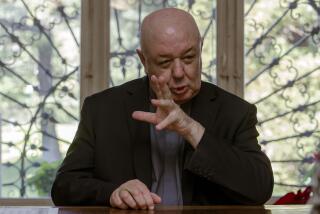Preserving the Mission Past : Archives: In San Juan Capistrano, one man has organized a priceless collection of thousands of documents, some written in the 1700s by Father Junipero Serra.
- Share via
SAN JUAN CAPISTRANO — Perhaps the richest historic treasures in old San Juan Capistrano lie on the fourth floor of St. John of Capistrano Catholic Church.
There, in a small, windowless room just below the church’s bell tower, are the priceless archives of 217-year-old Mission San Juan Capistrano. Lining the shelves of the room, high above the mission grounds, are maps, deeds, photographs, prayer books, newspapers and letters about the mission that have been carefully organized and chronicled by archivist Charles A. Bodnar.
Bound in stained cowhide are baptismal and funeral records from the 1770s, distinctively handwritten in Spanish by the founder of the mission, Father Junipero Serra. The documents were written with a quill pen dipped in ink that was distilled on the mission grounds.
Tucked inside a drawer is a parchment scroll deeding the mission back to the Catholic Church from the private holdings of the Forster family, whose descendants still live in San Juan Capistrano. The deed was signed by President Abraham Lincoln on March 18, 1865, just a few weeks before he was assassinated.
Side by side on two shelves are the first volumes of “The History of the West,” written and published in 1889 by Hubert Howe Bancroft.
A total of 1,800 volumes surround Bodnar’s small desk.
Besides books and papers, there are aged oil paintings, some by unknown artists, that have been donated to the mission, as well as old nitrate negatives, sculptures, videotapes and even a patent for a portable cuspidor given to Father St. John O’Sullivan, a mission pastor.
Although not open to the public without a formal appointment, the archives provide a valuable resource for historians interested in old California, the 21 missions or Serra, who founded the first nine of them, Bodnar said.
“These archives are actually a research facility,” said Bodnar, 79, a retired banker and 38-year resident of San Juan Capistrano. “Most of the material centers (on) the mission, its people, its history, its various rooms and wings. This is one of only two missions--the other is in Santa Barbara--that has this kind of library.”
It has only been through Bodnar’s painstaking efforts over the past eight years that the Catholic Diocese of Orange has discovered the treasures it owns. Bodnar, who opened the Bank of America branch in San Juan Capistrano in the late 1960s, had developed a sense for research while working in his banking career.
Starting in 1985, he sorted through the old boxes stored on shelves in the rectory on the mission grounds. Although much of the collection was soiled by the elements and the years, it was the beginning of what is now between 5,000 and 6,000 pieces of history that make up the archives.
“We cannot even attempt to put a price on these things,” Bodnar said. “There is really no money in these religious books, not yet anyway. But we are very proud of what we have here.”
The focus of much of the collection is Serra, the determined Franciscan priest who, despite a diseased leg, managed to limp his way north from the tip of Baja California, founding missions and converting inhabitants along the way.
“He was bitten on the leg by something, maybe a rattlesnake, a scorpion or a mosquito,” Bodnar said. “But he still managed to walk 5,000 miles on that bad leg.”
More to Read
Sign up for Essential California
The most important California stories and recommendations in your inbox every morning.
You may occasionally receive promotional content from the Los Angeles Times.













